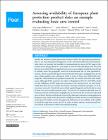| dc.contributor.author | Stout, Jane | |
| dc.date.accessioned | 2022-08-18T06:24:59Z | |
| dc.date.available | 2022-08-18T06:24:59Z | |
| dc.date.issued | 2022 | |
| dc.date.submitted | 2022 | en |
| dc.identifier.citation | López-Ballesteros A, Delaney A, Quirke J, Stout JC, Saunders M, Carolan J, White B, Stanley DA, Assessing availability of European plant protection product data: an example evaluating basic area treated, Peer J, 2022, 10:e13586 | en |
| dc.identifier.other | Y | |
| dc.identifier.uri | http://hdl.handle.net/2262/101070 | |
| dc.description | PUBLISHED | en |
| dc.description.abstract | Besides the benefits of plant protection products (PPPs) for agricultural production,
there is an increasing acknowledgement of the associated potential environmental
risks. Here, we examine the feasibility of summarizing the extent of PPP usage at the
country level, using Ireland as a case study, as well as at the European level. We used
the area over which PPPs are applied (basic area) as an example variable that is relevant
to initially assess the geographic extent of environmental risk. In Irish agricultural
systems, which are primarily grass-based, herbicides fluroxypyr and glyphosate are the
most widely applied active substances (ASs) in terms of basic area, followed by the
fungicides chlorothalonil and prothioconazole that are closely associated with arable
crops. Although all EU countries are subject to Regulation (EC) No 1185/2009, which
sets the obligation of PPP usage data reporting at the national level, we only found
usable data that met our criteria for Estonia, Germany, Finland, and Spain (4 of 30
countries reviewed). Overall, the most widely applied fungicide and herbicide in terms
of basic area were prothioconazole (20%, 7% and 5% of national cultivated areas of
Germany, Estonia and Ireland) and glyphosate (11%, 8% and 5% of national cultivated
areas of Spain, Estonia and Ireland) respectively, although evaluations using application
frequency may result in the observation of different trends. Several recommendations
are proposed to tackle current data gaps and deficiencies in accessibility and usability
of pesticide usage data across the EU in order to better inform environmental risk
assessment and promote evidence-based policymaking. | en |
| dc.language.iso | en | en |
| dc.relation.ispartofseries | Peer J; | |
| dc.rights | Y | en |
| dc.subject | Pesticides | en |
| dc.subject | Exposure | en |
| dc.subject | European policy | en |
| dc.subject | Agrichemical | en |
| dc.subject | Plant protection product | en |
| dc.subject | Active ingredients | en |
| dc.title | Assessing availability of European plant protection product data: an example evaluating basic area treated | en |
| dc.type | Journal Article | en |
| dc.type.supercollection | scholarly_publications | en |
| dc.type.supercollection | refereed_publications | en |
| dc.identifier.peoplefinderurl | http://people.tcd.ie/stoutj | |
| dc.identifier.rssinternalid | 245071 | |
| dc.identifier.doi | http://doi.org/10.7717/peerj.13586 | |
| dc.rights.ecaccessrights | openAccess | |
| dc.subject.TCDTheme | Smart & Sustainable Planet | en |
| dc.subject.TCDTag | PESTICIDES | en |
| dc.subject.TCDTag | POLLUTION | en |
| dc.subject.TCDTag | Sustainable Agriculture | en |
| dc.identifier.rssuri | https://peerj.com/articles/13586/ | |
| dc.identifier.orcid_id | 0000-0002-2027-0863 | |
| dc.status.accessible | N | en |
| dc.contributor.sponsor | Department of Agriculture, Fisheries and Food (DAFF) | en |




